1. Disease Management of Agricultural Crops
2. Disease Management of Horticultural Crops
1. Disease Management of Agricultural Crops
Diseases of Rice
Nursery disease
Blast (Pyricularia Oryzae Cavara)
Symptoms
-
Disease can infect paddy at all growth stages and all aerial parts of plant (Leaf, neck and node).
-
Among the three leaf and neck infections are more severe.
-
Small specks originate on leaves - subsequently enlarge into spindle shaped Spots(0.5 to 1.5cm length, 0.3 to 0.5cm width) with ashy center.
-
Several spots coalesce to form big irregular patches
- Unde severe leads to
- lodging of crop (after ear emergence)
Neck Blast
Internode Blast
Control
-
Use of tolerant varieties (Penna, Pinakini, Tikkana, Sreeranga, Simphapuri, Palghuna, Swarnamukhi, Swathi, Prabhat, IR - 64, Jaya, IR - 36, MTU 9992, MTU 1005, MTU 7414).
-
Burning of straw and stubbles after harvest.
Bacterial Leaf Blight
Symptoms
-
Seedling wilt or kresek
-
Water-soaked to yellowish stripes on leaf blades or starting at leaf tips then later increase in length and width with a wavy margin.
-
Appearance of bacterial ooze that looks like a milky or opaque dewdrop on young lesions early in the morning.
-
Lesions turn yellow to white as the disease advances.
-
Green water-soaked layer along the cut portion or leaf tip of leaves as early symptom.
Control
- Secure disease free seed
- Grow nurseries preferably in isolated upland conditions
- Drain the field (except at flowering stage of the crop)
- Destruction of wild collateral hosts
- Avoid flow of water from affected fields
- Grow tolerant varities (Swarna, Ajaya, Deepti, Badva mashuri, MTU-9992).
Sheath Rot (Sarocladium oryzae)
Symptoms
-
Irregular spots or lesions, with dark reddish brown margins and gray center
-
Discoloration in the flag leaf sheath
-
Lesions enlarge and often coalesce and may cover the entire leaf sheath
-
Severe infection causes entire or parts of young panicles to remain within the sheath
-
Unemerged panicles rot and florets turn red-brown to dark brown
-
Whitish powdery growth inside the affected sheaths and young panicles
-
Infected panicles sterile, shrivelled, or with partially filled grain
Control
Brown Spot ( Helminthosporium oryzae)
Symptoms
-
Occur in nursery as well as main crop
-
Causes blight of seedlings
-
Leaf spotting is very common
-
Isolated brown, round to oval (resemble sesame seed)
-
Spots measures 0.5 to 2.0mm in breadth - coalasee to form large pathces.
-
Seed also infected (black or brown spots on glumes) (spots are covered by olivaceous velvety growth)
-
Infection also occur on panicle neck with brown colour appearance
-
50% yield reduction in severe cases
Control
False Smut (Ustilaginoidea viridis)
Symptoms
-
Individual rice grain transformed into a mass of yellow fruiting bodies
-
growth of velvety spores that enclose floral parts
-
immature spores slightly flattened, smooth, yellow, and covered by a membrane
-
growth of spores result to broken membrane
-
mature spores orange and turn yellowish green or greenish black
-
only few grains in a panicle are usually infected and the rest are normal
Control
Tungro Virus (Rice Tungro Virus)
Symptoms
-
Plants affected by tungro exhibit stunting and reduced tillering. Their leaves become yellow or orange-yellow, may also have rust-colored spots.
-
discoloration begins from leaf tip and extends down to the blade or the lower leaf portion.
-
delayed flowering, - panicles small and not completely exserted.
-
most panicles sterile or partially filled grains.
Control
-
Grow tolerant varieties like MTU 9992, MTU 1002, MTU 1003, MTU 1005, Surekha, Vikramarya, Bharani, IR 36 etc.,
-
In epidemic areas follow rotation with pulses or oil seeds.
Leaf streak (Xanthomonas oryzae pv. oryzicola)
Control
Diseases of Sugarcane
Red Rot (Colletotrichum falcatum)
Symptoms
-
The first symptom of red rot in the field is discolouration of the young leaves. The margins and tips of the leaves wither and the leaves droop.
-
The discolouration and withering continues from the tip to the leaf base until the whole crown withers and the plant dies, within 4 to 8 days.
-
In a single stool, most of the stalks may wither almost simultaneously.
-
As the disease advances the entire stem rots and the central tissues become pithy.
-
The tissues are reddened throughout the basal portion, especially the vascular bundles, which are intensely red; there may be cross-wise white patches interrupting the reddened tissues.
-
The internodes may shrink and when such canes are split open large cavities may be found in the centre and the pithy tissues may appear brown.
-
Often a profuse whitish growth of the fungal mycelium may be found in the brown background of the host tissue.
-
In some cases, black, minute, velvety bodies, representing the acervuli of tire fungus, may also be seen.
-
Since reddening is a common symptom of other diseases of sugarcane, the white patch symptom is an important diagnostic characteristic of red rot.
-
When a diseased plant is open, a characteristic becomes evident.
-
In the infected plants the leaves may show symptoms in the form of dark red lesions in the mid-rib, which may elongate, turning blood-red with dark margins and later on with straw-coloured centres.
-
In the older lesions minute black dots, representing the acervuli, can be seen. Often the infected leaves may break at the lesions and hand down.
Control
-
Red rot management in sugarcane has become an important issue in all sugarcane areas. While early stage detection may not be quite easy, during later stages, the cane breaks down.
-
The canes are to be split open lengthwise to see dull red tissue, interrupted by white patches across the stalk. These patches are characteristic of red rot of sugarcane. Monsoon period enables faster disease spread and drying of the crop.
-
The best remedy for avoiding this fungal disease is to cultivate only resistant sugarcane varieties that have been released for cultivation in different sugarcane growing states. Phytosanitation, being the key to manage this disease, stringent domestic quarantine measures to prevent movement of cane setts from endemic areas to new areas has to be enforced by all concerned agencies including sugar mills.
-
In recent times, the disease has spread into many states.
-
Following good cultural practices such as clearing fields of excessive trash and ensuring efficient drainage.
-
Healthy setts only are to be planted to avoid poor plant stand due to rotting.
-
Affected fields should be isolated through bunding to prevent movement of water to adjacent fields.
-
Rattooning of infected fields should be strictly avoided.
-
Crop rotation in the affected fields could reduce disease inoculum.
-
Hot water treatment of setts before planting at 52 degree C for 30 minutes is also recommended.
-
In addition to the various sanitary precautions mentioned above, red rot may also be controlled by growing resistant or tolerant varieties. Inter-generic and inter-specific crosses with Saccharum spp., in the latter case using S.spopntaneum and S. robustum with S. officinarum have yielded many economically important cane varieties, some of which are highly resistant, or at least tolerant, to red rot.
Cultivation of resistant varieties
By far the most effective measure for management of red rot is use of resistant varieties for cultivation. Varieties viz. Co 8021, Co 85019, Co 86010 and Co 86032, Co86249 and Co 93009, Co 99004 and Co 99006 are tolerant/resistant to red rot in Tropical India. The varieties Bo 91, Co89003, Co 98015, Co 99015, Co 99016, Co S 96275, Co S 99259, Co Pant 90223 and Co Pant 94211 are resistant in SubTropical India.
Sett rot or Pine Apple disease (Ceralocystis paradoxa, Ceratostomella paradoxa)
Symptoms
-
The disease primarily affects the sugarcane setts.
-
When diseased setts are planted they may rot before germination, or the shoots may die after reaching a height of about 6-12 inches.
-
If infected shoots survive, they are very much stunted and chlorotic.
-
Eventually the leaves may wither and the shoots wilt.
-
If the affected shoots and setts are examined the central portion of the shoots will be seen discoloured red and the contents of the sett rotting.
-
A characteristic pineapple smell is associated with the rotting and hence the name.
Control
-
Healthy setts should be obtained from disease-free field.
-
They should be carefully selected and treated with an organomereurial before planting, to protect the cut-ends from invasion by the fungus.
-
Pretreating the setts with hot water has been found to stimulate germination of buds and hasten growth so as to help the young plants to overcome the competition with the pathogen.
Wilt (Cephalosporium sacchari)
-
This is one of the early known diseases of sugarcane in India.
-
It was first reported by Butler and Khan in 1913, from North India.
-
It has been reported to cause severe damage to sugarcane crops in many parts of India. During 1965-1967 it caused severe damage to sugarcane crop in the Deccan plateau
-
Same disease has been reported from Mexico, Argentina, Barbados, Columbia, Trinidad, Uganda, South Africa and United States of America.
Symptom
-
The first symptoms of the disease become apparent only when the plant has grown for about 4-5 months.
-
The canes show gradual withering.
-
On examination of affected clumps , the pith will be seen discoloured purple or dirty reef, with longitudinal streaks.
-
The leaves of affected clumps gradually turn yellow and dry up.
-
A characteristic disagreeable odour is also associated with such diseased canes.
-
A cottony white mycelium can also be seen in the pith region.
-
Frequently this fungal disease is associated with a saprophytic bacterial growth and often the bacteria are mistaken as causal agents.
Control
-
The disease is controlled by selecting seed setts from disease free areas.
-
Alkaline soils may be avoided for growing the crop.
-
The varieties Co-617 and B.P.-17 are more resistant than others; hence they should be used when growing crop in the wilt-sick soils.
Grassy Shoot
Symptoms
-
The disease is characterized by proliferation of vegetative buds from the base of the cane giving rise to crowded bunch of tillers bearing narrow leaves.
-
The tillers bear pale yellow to completely chlorotic leaves.
-
Cane formation rarely takes place in affected clumps and if formed the canes are thin with short internodes.
-
The virus is readily transmitted by sap inoculation and in the field it is transmitted through infected setts and perpetuated through crop ratooning. The aphids are the vectors for this disease.
-
The same virus also infects jowar, Napier grass and Madras grass.
Control
-
The disease is controlled by eradication of diseased parts as soon as symptoms are noticed
-
Avoid selection of setts from diseased area.
-
Pre-treating the healthy setts with hot water at 52°C for 1 hour before planting
-
Treating them with hot air at 54°C for 8 hours and spraying twice a month with aphidicides.
Ratoon Stunting
Symptoms
- This is a virus diseases of sugarcane found in some parts of India in recent years.
- The affected plants are stunted, the stunting being most severe in stubble and ratoon crops.
- The setts taken from diseased plants germinate poorly and the few shoots that emerge grow very slowly.
- The virus infects many hosts falling under Graminae.
- It is sap-transmissible and no insect vector has been found.
Control
-
The disease spreads mainly through planting material, setts should be selected from healthy plants.
-
Treating the setts in hot water at 500C for about 2 hours gives 100 per cent control and has become a regular practice in many countries.
Mosaic
Symptoms
-
This disease was first observed in Java in 1892 and since then it has been reported from almost every sugarcane growing tract of the world.
-
The disease carries different names in different countries but the most common name is 'sugarcane mosaic.'
-
During 1919-1920 it caused devastating damage to the sugar industry in Puerto Rico and Cuba, and this led to concentrated studies to establish the causal agent, which was uncertain until about 1920.
-
In India the disease was identified during the early thirties of this century and has been reported since then from almost all the sugarcane tracts of the country.
-
The intensity of the disease and the loss in crop yield vary considerably, depending upon the host variety and climatic conditions.
Control
-
In the early years of this disease attempts were made in Java and other countries to completely eradicate it by cutting and burning the diseased plants.
-
Later it was realised this not only was not easy to do, but also it was necessary because of the availability of resistant varieties.
-
Roguing infected plants and chemical sprays to kill the insect vectors are also advocated.
-
However, the most practical method of controlling the disease is to grow mosaic-resistant or, at least, tolerant varieties.
-
Introduction of mosaic-susceptible varieties during earlier years, produced at the Sugarcane Research Institute, Coimbatore, in other areas of the world often resulted in devastating damage to the crop.
-
This emphasized the need to breed mosaic-resistant varieties.
-
At present the newer varieties are invariably tested for resistance to mosaic and other severe disease, before they are released for large-scale cultivation.
-
Saccharum spontaneum L. and S. barberi Jesweit carry resistance to mosaic.
-
Most of the popular sugarcane varieties under cultivation in India are resistant or tolerant to the disease.
-
The occurrence of another virus disease, Ring mosaic, on sugarcane in India was also reported recently.
-
It causes ellipitic rings with well developed yellowish or dark green centres.
Diseases of Cotton
Alternaria leaf spot
Symptoms
-
Small, pale to brown, round or irregular spots measuring 0.5 - 3 mm in diameter and cracked centres appears on the affected leaves of the plant.
-
Affected leaves become dry and fall off.
-
The disease may cause cankers on the stem.
-
The infection spreads to the bolls and finally fall off.
Control
Anthracnose (Collectotricum gossypium)
Symptoms
-
On the cotyledons and primary leaves of the seedling it forms small, reddish or light coloured diseased spots.
-
Stems are frequently attacked through the wounds and plants are rendered weak.
-
Bolls of all stages attacked.
-
Fungus invades the lint and seed.
-
Lint becomes yellow or brown and gets clumped into a mass of fibre.
-
The bolls affected by the disease have small, water-soaked, circular, slightly depressed, reddish brown spots.
-
Badly affected seeds are light, brown, poorly developed and usually do not germinate.
Control
Areolate or Grey mildew
Symptoms
-
It usually appears on plants, which are coming to maturity.
-
Irregular, angular, pale translucent spots measuring 1-10mm (3-4mm) in diameter and bordered by the veinlets, appear on the older leaves.
Control
Wilt (Fusarium vasinfectum)
Symptoms
-
Affects the host at all the stages of growth.
-
Earliest symptoms to appear on the seedling is the yellowing and browning of the cotyledons.
-
In young and grown up plants the leaves loose their turgidity first turn yellow and then brown and finally drop off.
-
The tap root of a wilted plant is usually stunted and laterals are less abundant.
-
Browning and blackening of vascular tissues. (Outstanding diagnostic symptoms)
-
Discoloration of woody tissues can be traced upon the surface of the host as a black streaks.
-
Discolouration of leaves starts from the margins and spread towards midribs.
-
Wilting may be complete or partial.
Control
-
Grow resistant varieties.
-
Provide good drainage.
-
Follow crop rotation 3-4 years once.
-
Destroy the infected - plant debris.
-
Apply 2 kg of Trichoderma viride commercial formulation with 50 kg farmyard manure along with the rows in the mainfield reduces the disease incidence.
Cultural Methods
Root Rot (Rhizoctonia bataticola)
Symptoms
-
The sudden and complete wilting of the plant (first and the most prominent symptoms).
-
Bronzing or yellowing of the leaves.
-
Plants succumbed to this disease exhibit roots particularly the bark, broken down into shreds.
-
Affected plants occur in more or less circular area and can be easily pulled out.
-
Except the tap root, few secondary roots are fresh which holds the plant and other roots are decayed.
-
Tip of the root of a freshly wilted plant is slightly moist and sticky.
Control
-
Inter cropping of cotton with moth bean (Vigna acomitifolia) reduce the incidence. (moth bean helps in reducing the temperature and retention of high soil moisture due to shading effect).
-
Adjustment of time of sowing when soil temperature is not high.
-
Mixed cropping with Moth bean (Vigna aconitifolia) check the disease intensity. .
-
Apply 2kg of Trichoderma viride commercial formulation with 50kg farmyard manure along with the rows in the main field reduces the disease incidence.
Diseases of Sunflower Downy Mildew (Plasmopara helianthi)
Symptoms 
Symptoms of the disease are evident as seedling damping off, systemic infection, local foliar lesions and basal root or stem galls.
-
First symptoms are yellowing of the first pair of true leaves.
-
Sunflower plants carrying systemic infection are severely stunted and leaves are entirely Chlorotic.
-
Affected plants bear abnormally thick, downward curled leaves showing prominent yellow and green mottling.
-
The stem becomes brittle.
-
On young seedlings under high humidity whitish growth of downy mildew may appear on the cotyledons.
-
There is pronounced reduction of secondary rootlets
-
Flower heads of the affected plants remain sterile and produce no seeds or only occasional.
-
When older plants are infected, symptom expression may be delayed till head formation.
-
Small angular greenish yellow lesions may appear on leaves as a result of secondary infection.
-
Fungal growth is visible at lower surface.
-
Such local infections are, however, considered to be of less importance.
Control
Alternaria Blight (Alternaria helianthi)
Symptoms

-
The disease is characterised by the development of dark brown to black, circular to oval spots varying from 0.2 to 5 in diameter.
-
The spots are surrounded by necrotic chlorotic zone with grey white necrotic centre marked with concentric rings.
-
Spots first appear on lower leaves, later spread to middle and upper leaves.
-
At later stages, spots may be formed on petioles, stem and ray florets.
-
Spots first appear on lower leaves, later spread to middle and upper leaves.
-
At later stages, spots may be formed on petioles, stem and ray florets.
Control
-
Occurrence and severity of the disease depend on the season and planting dates.
-
Resistant sources identified are EC 132846, EC 132847, EC 132361 and EC 126184.
Powdery Mildew (Erysiphe cichoracearumf. sp. helianthi., Erysiphe cichoracearum)
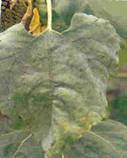
Symptoms
-
Occasionally the symptoms appear on stem and bracts.
-
White to grey areas enlarge, coalesce and cover most plant parts.
-
As the season advances cleistochecia become visible as black pinpoints over the white mildew areas.
-
Pathogen survives through cleistothecia.
-
The disease has not been observed to be of any economic importance.
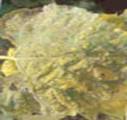
Control
Rhizopus Head Rot (Rhizopus sp)
Symptoms
 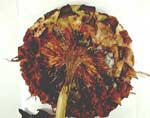
-
Initial symptom appears as brown irregular water soaked spots on the back of ripening head usually adjacent to flower stalk.
-
Spots gradually enlarge and become soft and pulpy and get covered with superficial white mycelium which later becomes black due to the appearance of sporangia.
-
In cases of severe infection, the rot spreads to flower stalk and the sunflower head drops off.
-
Some seeds of the rotted heads shed and those which remain in the head taste bitter.
Control
-
To have effective control of the disease, simultaneous application of compatible insecticide and fungicide beginning with the completion of flowering stage is suggested.
-
Injury to the head should be avoided as far as practicable.
Virus Diseases Of Sunflower
-
Several virus and virus like diseases have been reported by various workers on sunflower, both in India and abroad.
-
Sunflower mosaic, chlorotic mosaic, yellow ring mosaic, yellow mosaic, yellow spot, chlorotic leaf/mosaic, greening, cucumber mosaic, curl mosaic and Mycoplasm like organisms (strain of tomato big bud, aster yellows and phyllody) have been reported.
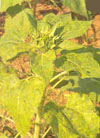
Sunflower mosaic virus (SMV)
-
Several kinds of symptoms have been described from India. Mosaic symptoms accompanied by ring spots or chlorotic spots which had a tendency to coalesce have been frequently reported.
-
Another mosaic virus described as mosaic and chlorotic rings that were more common on young leaves which make the plants stunted, producing malformed heads and shrivelled seeds.
-
Symptoms as small circular spots on leaves which coaleasced to form typical mosaic pattern, cupping and malformation of leaves have also been reported.
-
Sunflower mosaic virus is reported to be mechanically sap transmitted and also by several aphid vectors.
-
The important vectors are Aphis gossypii, A.craccivora, A.malvae, Rhopalosiphum maidis in a non-persistant manner, both under laboratory and natural field conditions.
-
The host range of this virus ranged from narrow, infecting only the cultivars of sunflower to as many as more than 25 plant species belonging to different families.
-
The dilution end point of different strains of this virus ranged between 1:1000 and 1:80000, thermal inactivation point ranged between 65 and 750C and the longevity in vitro ranged up to 4-5 days at room temperature.
Aphid transmitted virus
-
This virus has been reported from Cambridge. The chief symptoms produced are chlorosis and thickening of lower leaves.
-
The interveinal areas of these leaves become bright yellow near the tip and margins, many irregular necrotic patches develop later on and these symptoms are reported to be similar to the sugarbeet yellowing virus.
-
This virus is transmitted by an aphid vector, Myzus persicae.
Yellow ring mosaic virus
-
This virus has been reported from India. It produces mosaic and yellow spot symptoms.
-
Severe mosaic accompanied by stunting and malformation of young leaves in the form of yellow rings has also been reported.
-
This virus is transmitted both by mechanical sap and also by leaf and cleft grafting and has an additional host, Chenopodium amaranticolor.
Tobacco streak virus
-
This virus has been reported from Argentina.
-
It produces mosaic symptoms follwed by necrosis and vein swelling severe necrosis and chlorosis on the leaves and curling of glumes are the additional symptoms.
-
It is transmitted through mechanical sap and also by dodder. Nicotiana clevelandi, N.rustica, Chenopodium amaranticolor, Gompherena globosa are the additional hosts of this virus.
-
The dilution end point of the virus ranged between 1:1000 and 1:10,000 thermal inactivation point ranged between 53 and 600C and the longevity in vitro ranged up to 48 hours at room temperature.
-
The electron microscopic studies revealed the presence of isometric particles measuring 30mm in size.
Yellow blotch disease
-
Distinct bright yellow blotches occurred on leaves crinkling was absent. Also, short, irregular yellow vein bands appear in the beginning and later coaleasced to form "Y" or concentric rings with either yellow or a green centre.
-
Some yellow bands coalesced to form brilliant yellow blotches measuring 1-3 cm in diameter.
-
In mildly affected plants, only a yellow vein-net involving some or all of the leaf surface was observed.
-
Under field conditions, some plants show more severe symptoms after yellow blotch appearance.
-
The youngest leaves were twisted, reduced in size and often curled downwards.
Leaf crinkle disease
-
The symptoms of this disease always develops first as yellow blotch, but later leaf crinkling symptoms dominate.
-
The electron miscroscopic studies of the group of symptoms of this disease revealed the presence of spherical particles measuring 26.8+0.15 mm in diameter.
Management Of Virus Diseases
-
Like in any other virus diseases of crop plants, there are no direct methods of controlling the viruses of sunflower.
-
Since the sunflower mosaic is transmitted both by mechanical means and also by aphid vectors in a non-persistant manner, it is very difficult to protect the plants from infection of the virus through this type of vectors.
-
However, the following methods helps much in reducing the incidence and further spread of the virus diseases in the field and thereby reducing the yield losses, have been suggested.
-
Following clean cultivation by removing the weeds both inside and neighbouring plots which helps to destroy the virus source and avoid the primary inoculum to the crop.
-
Prophylactic sprays with suitable insecticides to control the insect vectors which come from outside the field and also harbouring inside the field, helps to avoid the primary sources and also further spread in the field.
-
Careful destruction of the infected plants as soon as they are noticed in the field will also help to avoid further spread of the viruses in the field by destroying the source of inoculum within the field.

Cultural Approach
-
Ploughing, harrowing, weeding, planting time, Organic amendments, fertiliser, use, intercropping, planting method, micronutrient balance, water use, etc., have impact on disease development of sunflower.
-
The oldest known cultural practice of crop is basically a classical approach for reduction of diseases.
-
A six year rotation in sunflower is found useful in the control of downy mildew in Russia and European countries.
-
Crop rotation also reduces alternaria blight, rust and soil borne diseases.
-
It is very clear that outbreak of sunflower downy mildew is ensured by water stagnation, deep sowing, continuous sunflower growing and those practices that delay emergence of seedling.
-
The influence of several practices on different diseases has been examined at number of locations in India.
-
It has been observed that early planting of sunflower during kharif reduces damage by Alternaria.

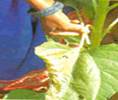
-
Also intercropping, spacing, manuring has great effect on diseases which could be exploited fully for the advantage of disease management summarizes the beneficial effects of some major cultural practices on sunflower diseases.
-
It is, therefore, suggested that emphasis on crop rotation, intercropping, timely planting, proper water use and field populations of sunflower be given a priority in management of disease.

Biological Approach
-
The soil borne pathogens particularly sclerotium, Macrophomina and fusarium can be efficiently reduced by the biocontrol agents trichoderma and gliocladium.
-
There is a great potential for application through seed as these systems have been widely used in other crops.
-
A concentrated effort is also necessary to examine the organic management of diseases through vermicuture biofertilizer, plant porducts like neem extract and neem oil and commercially available natural products.
-
The role of vasicular arbascular mycorrhiza (VAM) has also not been investigated which could be a part of integrated management.
Diseases of Ground nut (Cercospora arachidicola)
Symptoms
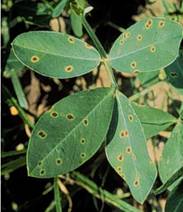
-
Infection starts about 1 month after sowing.
-
Small chlorotic spots appear on leaflets, with time they enlarge and turn brown to black and assume sub circular shape on upper leaf surface.
-
On lower surface of leaves light brown colouration is seen.
-
Lesions also appear on petioles, stems, stipules..
Cultural Control
-
Grow tolerant varieties can be grown wherever early leaf spot is severe.
-
Intercropping pearl millet or sorghum with groundnut (1 : 3) is useful in reducing the intensity of early leaf spot.
-
Crop rotation with non-host crops preferably cereals.
Mechanical Control
Biological Control
Late leaf spot (Phaeoisariopsis personatum)
Symptoms
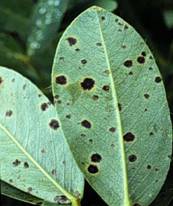
Cultural Control
- Use of resistant/tolerant varieties wherever late leafspot is severe.
- Intercropping pearl millet or sorghum with groundnut (1 : 3) is useful in reducing the intensity of late leafspot.
- Crop rotation with non-host crops preferably cereals.
Mechanical Control
Biological Control
Rust (Puccinia arachidis)
Symptoms
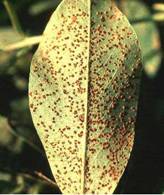
Rust can be readily recognized as orange coloured pustules (uredinia) that appear on the lower leaflet surface and rupture to expose masses of reddish brown urediniospores.
-
Pustules appear first on the lower surface and in highly susceptible cultivars the original pustules may be surrounded by colonies of secondary pustules.
-
Pustules may also appear on the upper surface of the leaflet.
-
The pustules are usually circular and range from 0.5 to 1.4 mm in diameter.
-
They may be formed on all aerial plant parts apart from flower and pegs.
Cultural Control
-
Crop rotation and field sanitation.
-
Strict plant quarantine regulations should be enforced to avoid the spread of rust on pods or seeds to disease free areas.
-
Early sowing in the first fortnight of June to avoid disease incidence.
-
Intercropping pearl millet or sorghum with groundnut (1 :3) is useful in reducing the intensity of rust.
-
Use resistant/tolerant varieties.
Mechanical Control
Biological Control
Crown rot (Aspergillus spp.)
Symptoms
-
Seeds may be killed in pre -emergence rotting.
-
Post-emergence infection causes death and rapid decay of seedlings.
-
Young plants collapse and die soon after emergence due to rotting of elongating hypocotyl.
-
Collar region become dark brown & shredded.
-
In mature plants large lesions develop on stem just below the soil surface & then spread upward along the branches causing wilting & death.
Cultural Control
Mechanical Control
Biological Control
Soft rot (Sclerotium rolfsii)
Symptoms
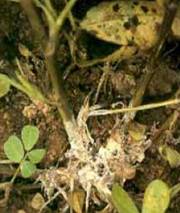
-
Development of white fungal threads over affected plant tissue particularly on stem.
-
Base of the plant turns yellow and then wilts down.
-
Sheaths of white mycelium develop around the affected areas of the stem near the soil due to this the stem becomes shredded.
-
White sclerotia of mustard seed size are produced in the infected tissues which later turn to brown colour.
Cultural Control
Biological Control
Bud necrosis (Peanut Bud Necrosis Virus - PBNV)
Symptoms
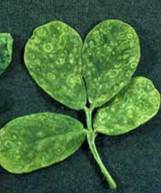
Chlorotic spots appear on young leaflets and necrotic rings & streaks are developed.
-
Terminal bud necrosis occurs when temperature is relatively high.
-
As the plant matures it becomes stunted with short internodes and proliferation of auxiliary shoots..
Cultural Control
-
Early sown crop during kharif and rabi/summer seasons is less infected.
-
Grow resistant varieties.
-
Destruct alternate weed hosts like Bidens pilosa, Erigon bonariensis, Tagetes minuta, Trifolium subterraneum.
-
Increase plant density, do early sowing, mixed cropping with pearl millet to restrict vector movement.
-
Groundnut should be intercropped with fast growing cereal crops such as pearl millet in 7:1 ratio.
Kalahasti malady (Tylenchorhynchus brevilineatus)
Symptoms
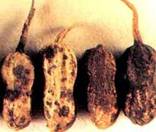
-
Infected plants appear in patches in the field, and are stunted with greener than normal foliage.
-
Small, brownish lesions appear on the pegs, and on young developing pods.
-
Peg length is reduced and in advanced stages of the disease the entire pod surface becomes blackened.
-
Discolouration is also seen on roots.
Cultural Control
Anthracnose (Colletotrichum dematium and C. capsici)
Symptoms 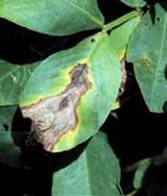
-
Small water-soaked yellowish spots appear on the lower leaves which later turn into circular brown lesions with yellow margin 1 to 3 mm in diameter.
-
In some cases lesions enlarge rapidly become irregular and cover the entire leaflet, and extend to the stipules and stems.
Cultural Control
Mechanical Control
Diseases of Maize
Maydis leaf blight (MLB) - Bipolaris maydis
Symptoms
-
Young lesions are small and diamond shaped.
-
As they mature, they elongate. Lesions may coalesce, producing a complete “burning” of large areas of the leaves.
-
They vary in size and shape among inbreds and hybrids with different genetic background.
-
Race ‘O’ produced tan, elongated (2-6x 3-22 mm) lesion between the veins with limited margins, with buff to brown borders, usually attacks only leaves.
Control
-
Resistant varieties – Deccan, VL 42, Prabhat, KH-5901, PRO-324, PRO-339, ICI-701, F-7013, F-7012, PEMH 1, PEMH 2, PEMH 3, Paras, Sartaj, Deccan 109.
-
Two applications of captafol
Sorghum downy mildew (Peronosclerospora sorghi)
Symptoms
-
The chlorotic area of leaf always includes the base of the blade, and transverse margins usually sharply defined between the diseased and healthy tissues
-
A white, downy growth may appear on both surface of infected leaves. Sometimes tassels of diseased plant may exhibit phyllody.
-
Tolerant plant may show symptoms of systemic infection but have normal seed production.
Control
-
Resistant varieties – Comp. A-9, Indimyt 345, EH-43861, KH-526, AH-36.
Brown stripe downy mildew (Scleropthora rayssiae var. zeae)
Symptoms
-
Lesions start developing on lower leaves as narrow chlorosis or yellow stripes,3-7 mm wide,with well defined margin and are delimited by the veins.
-
The stripes later become reddish to purple.Lateral development of lesions causes sever striping and blotching.
-
Seed development may be suppressed,and plant may die prematurely if blotching occurs prior to flowering.
-
Sporangia on the leaves appear as a downy whitish to wooly growth on both surface of the lesions.
-
Floral or vegetative parts are not malformed, and the leaves do not shred.
Control
-
Resistant varieties -Prabhat, Kohinoor, ICI-703, PAC-9401, PMZ-2, SEEDTEC-2331, BIO-9681 (Y) etc.
Brown spot (Physoderma maydis)
Symptoms
-
The first noticeable symptoms develop on leaf blades and consist of small chlorotic spots, arranged as alternate bands of diseased and healthy tissue. Free water and high temperatures(23-300C) is favorable for this disease.
-
Spots on the mid-ribs are circular and dark brown, while lesions on the laminae continue as chlorotic spots. Nodes and internodes also show brown lesions.
-
In severe infections, these may coalesce and induce stalk rotting and lodging.
Control
-
Planting corn early allows to escape infection.
-
Removing of Saccharum spontaneoum grass growing around the crop, can minimise the diease.
-
Systemic fungicides mainly based on acylalamines such as, metalaxyl (Ridomil 25 WP, Apron 35 SD, Apron 35 FN)
-
Resistant varieties – Ganga 11,Deccan, Deccan 103,Composite Suwan1, F-9572 A, JKMH-178-4, FH-3113
Pythium stalk rot (Pythium aphanidermatum)
Symptoms
-
Usually the basal internodes become soft, dark brown water soaked, causing the plants lodge.
-
Damaged internodes commonly twist before the plants lodge. Diseased plants can remain alive until all vascular bundles become affected.
-
Isolations in culture media are necessary to differentiate Pythium from Erwinia stalk rots.
Control
-
Planting time between 10 & 20 July in Northern India.
-
Maintain plant population around 50,000/ha.
-
Good field drainage.
-
Removal of previous crop debris.
-
Resistant varieties – Ganga, Safed 2
Bacterial stalk rot (Erwinia chrysanthemi pv zeae)
Symptoms
-
The stalk near the ground become water-soaked with brownish discolouration and are easily breakable.
-
The rotting tissues emit a putrid smell.
-
Infected plants show dark colour and water soaking at the base of the stalk. Plants die shortly after tasseling.
-
The bacterial decomposition produces an unpleasant odor.
Control
Charcoal stalk Rot (Macrophomina phaseolina)
Symptoms
-
Disease appears 1-2 weeks after the flowering. The outside of the lower internode becomes straw coloured.
-
The pith becomes badly disintegrated.
-
The pathogen invades seedling roots. When plants approach maturity, the internal parts of stems show a black discolouration and shredding of the vascular bundles.
-
This occurs mainly in lower stalk internodes. Careful examination of rind and vascular bundles of infected plants easily reveals small black sclerotia which can overwinter and infect next crop.
-
Fungus may infect kernels which cause them blacken completely.
-
Disease favoured by high soil temperature 30-42o C and low soil moisture.
Control
-
Avoiding water stress at flowering time can reduce disease incidence,
-
Apply Trichoderma in furrows after mixing with FYM @ 1kg/100kg FYM/acre (mix 10 days before use in field)
Fusarium stalk rot (Fusarium moniliforme)
Symptoms
-
Affected plant wilt,leaves change from light to dull green, and the lower stalks become straw coloured.
-
Reddish discoloration occurs inside the infected stalk.
-
The internal pith tissue disintegrates, leaving only the vascular bundles.
-
Fungus enter through roots and grow up in to lower stem.
-
If infection occurs just after flowering, husks appear bleached and straw coloured.
Control
-
Seed from infected areas should not be planted.
-
Rotation with other crops.
-
Resistant varieties – Ranjit and Ganga 5
-
Single Cross – CM 103 x CM 104, CM 400 x CM 300
Head Smut (Sphacelotheca reiliana)
Symptoms
The head is either completely or partially replaced by a large whitish gall. The spores are blown away, exposing the dark filaments.
Control
In the areas where the disease occurs commonly, the best practice is to plant resistant cultivars.
Long Smut (Tolyposporium ehrenbergii)
Symptoms
The sori or spore sacs are cylindrical, elongate, usually slightly curved with a relatively thick creamy-brown covering membrane (peridium).
Control
Use of resistant cultivars and destruction of infective heads, grains is recommended. Removal of alternate host around the area will reduce initial inoculum pressure.
Smut (Sphacelotheca cruenta)
Symptoms
A characteristic feature of the sori, which vary in length from 3 to 18 mm, is the solid long black (often curved) pointed columella which extends almost the full length of the sorus and which remains conspicuous after the smut spores have been blown away.
Control
Where the disease is prevelant ratooning of sorghum crop is not recommended.
Sorghum Downy Mildew
Symptoms
Abundant downy white growth (conidiophores and conidia) is produced nocturnally on the under surfaces of infected portions of leaves during humid weather.
Control
Seed treatment mentality, use of resistant cultivars and deep ploughing of fields to bury oospore inoculum are the recommended measures.
Anthracnose and Red Rot (Colletotrichum graminicola)
Symptoms
Many lesions may develop close together and coalesce to kill large portions of the leaf.
Mid-rib infection often occurs and is seen as elongate-elliptical red or purple lesions on which the black acervuli can be clearly seen. Infected stems when split open show discoloration (depending on cultivar) which may be continuous over a large area, or more marbled appearance.
Control
Anthracnose can be best controlled by using resistant cultivars.
Alternaria leaf spot(Alternaria sesame)
Symptom
-
The pathogen attacks all parts of the plant at all stages.
-
Small, dark brown water soaked, round to irregular lesions, with concentric rings, 1-8 mm in diameter appear on the leaves and under excessive atmospheric and soil humidity the spot increases in size and number.
-
The lesions may also appear on the midrib and veins of the leaves.
Control
-
Grow resistant/tolerant variety like Krishna.
-
Destruction of crop residues and weeds.
-
Early planting i.e. immediately after onset of monsoon.
-
Follow intercropping system of sesamum + sunflower (3:1).
Bacterial blight (Xanthomonas campestris pv. Sesami)
Symptom
-
Plants of all stage are affected.
-
Water soaked, small and irregular spots are formed on the leaves which later increases and turn brown, under favourable conditions.
-
Leaves become dry and brittle, severely infected leaves defoliate.
Control
-
Crop rotation.
-
Use resistant variety like T-58.
-
Early planting i.e. immediately after onset of monsoon.
-
Destruction of crop residues.
-
Seed treatment with hot water at 52 o C for 10 minutes.
Bacterial leaf spot (Pseudomonas syringae pv. Sesami)
Symptom
-
Light brown angular spots with dark purple margin appear in the leaf veins.
-
Defoliation and death of plant may occur in severe leave and stem infection.
-
Sunken and shiny spots are appeared on the capsules.
Control
-
Use white seeded early varieties.
-
Crop rotation.
-
Use resistant varieties.
-
Destruction of crop residues.
-
Seed treatment with hot water at 52o C for 10 minutes.
Cercospora leafspot / White spot (Cercospora sesami, C. sesamicola)
Symptom
-
Disease appears as small, angular brown leaf spots of 3 mm diameter with gray centre and dark margin delimited by veins.
-
In severity of the disease defoliation occurs.
-
Under favourable conditions, the disease spreads to leaf petiole, stem and capsules producing linear dark coloured deep seated lesions.
Control
-
Grow resistant/tolerant variety like TKG-21.
-
Early planting i.e. immediately after onset of monsoon.
-
Follow intercropping system of sesamum + pearl millet (3:1).
-
Destruction of plant debris.
Corynespora blight (Corynespora cassiicola)
Symptom
-
On leaves purple brown specks which develop into large spots.
-
Infected leaves curl and defoliate.
-
On stem, purple brown elongated lesions appears.
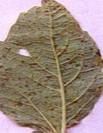
Control
-
Destruction of weed and crop residues.
-
Field sanitation.
-
Early planting i.e. immediately after onset of monsoon.
-
Follow intercropping system of sesamum+pearl millet (3:1).
Damping off / Root Rot (Macrophomina phaseolina)
Symptom
-
The fungus attacks young seedling, their stem become water soaked soft and incapable of supporting the seedling which falls over and dies.
-
On older seedlings elongated brownish black lesions appear which increase in length and width girdling the stem and plant dies.
Control
Phytophthora blight (Phytophthora parasitica var. Sesami)
Symptom
-
Disease can attack at all stages of the plant.
-
Initial symptom is water soaked spots on leaves and stems.
-
The spots are chestnut brown in the beginning later turn to black.
-
Premature leaf fall occurs.
-
In humid weather, severity of disease increases, main root is affected, diseased plants are easily pulled out leaving lets and cortex behind, and produce shriveled seeds and gives blighted appearance.
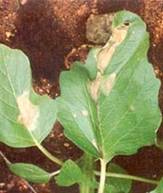
Control
-
Follow two year crop rotation.
-
Deep summer ploughing.
-
Provide good drainage.
-
Late planting
-
Use resistant tolerant varieties like TKG-22, TKG-55 and JTS-8.
-
Intercropping system, sesamum+pearl millet(3:1) should be followed.
-
Destruction of crop debris.
-
Rougue out diseased plants.
-
Soil amendment with biological control agent like Trichoderma harzianum and Trichoderma viride or seed treatment with T. Harzianum/ T. viride / Bacillus subtilis (0.4%)
Powdery mildew (Oidium sp. Sphaerotheca fudiginia, Leveillula)
Symptom

Control
Field sanitation.
-
Destruction of crop residues.
-
Early planting i.e. immediately after onset of monsoon.
-
Follow intercropping system of sesamum + pearl millet (3:1).
-
Use resistant variety RT-127
-
Destruction of crop residues and alternate hosts.
Sesame phyllody (Phytoplasma like organism)
Symptom
-
All floral parts are transformed into green leafy structures followed by abundant vein clearing in different flower parts.
-
In severe infection, the entire inflorescences is replaced by short twisted leaves closely arranged on a stem with short internodes, abundant abnormal branches bend down.
-
Finally, plants look like witches broom.
Control
-
Delay in planting of sesamum about 3 weeks after onset of monsoon.
-
Use intercropping system, sesamum + pigeon pea (1:1).
-
Use resistant varieties.
-
Provide plant spacing.
-
Destruction of diseased plants.
Stem and root rot (Rhizoctonia bataticola & Macrophomina phaseolina)
Symptom
-
The affected plants show wilting.
-
At ground level stem becomes black which extends upward rupturing the stem.
-
Black dots appear on the infected stem which are the pycnidia of the fungus.
-
If wilted plant is uprooted, black coloured roots are observed having sclerotia of the fungus and looks as if charcoal is sprinkled on the root.
-
The roots become brittle.
-
In diseased plants black pods are seen which open prematurely exposing shriveled and discoloured seeds.

Control
-
Deep summer ploughing.
-
Provide good drainage.
-
Late planting.
-
Do crop rotation or change the field after every two years.
-
Follow intercropping system sesamum + mothbean 1:1 or 2:1 ratio.
-
Whenever necessary, irrigate field every two weeks to avoid stress condition.
-
Use resistant varieties.
-
Destruction of crop residues.
-
Soil incorporation of biological control agents like Trichoderma harzianum, Trichoderma viride.
-
Treat the seed with T. viride or T. harzianum or Bacillus subtilis (0.4%).
Alternaria leaf spot (Alternaria alternaria A. Tenuissima)
Symptom
-
The disease occurs rarely on green gram and can be seen in all the seasons.
-
Initially, small, circular brown spots appear on the leaf surface.
-
Gradually, the spots become dark brown with concentric circles.
-
As the severity increases, the spots enlarge and the concentric rings become clearly visible.
-
Affected portions in the leaf get separated and fall down resulting in shot holes.
Cultural Control
Anthracnose (Colletotrichum lindemuthianum, C. Capsisi)
Symptom
-
The fungus attacks all aerial part parts and at any stage of plant growth.
-
Symptoms are circular, black, sunken spots with dark center and bright red orange margins on leaves and pods.
-
In severe infections, the affected parts wither off.
-
Seedlings get blighted due to infection soon after seed germination.
Cultural Control
Bacterial leaf blight (Xanthomonas phaseoli)
Symptom
-
It is characterized by many brown, dry and raised spots on the leaf surface.
-
When the disease is severe several such spots coalesce, the leaves become yellow and fall off prematurely.
-
The lower surface of the leaf appears red in colour due to the formation of raised spots.
Cultural Control
Mechanical Control
Cercospora leaf spot (Cercospora canescens)
Symptom
-
This is an important disease of green gram and is usually occurs in a severe form, causing heavy losses in yield.
-
Spots produced are small, numerous in number with pale brown centre and reddish brown margin. Similar spots also occur on branches and pods.
-
Under favourable environmental conditions, severe leaf spotting and defoliation occurs at the time of flowering and pod formation.
Cultural Control
-
Cultivate resistant varieties.
-
Intercrop the moong with tall growing cereals and millets.
-
Follow clean cultivation.
-
Use disease free seed.
-
Maintain low crop population density and wide row planting.
Biological Control
-
The crude extracts of cassava, spiny amaranth, poinsettia, ipil-ipil, alascuatro, tagetes, garlic, mayana and zinger are applied for controlling the disease effectively.
Mechanical Control
Leaf curl (Leaf Curl Virus)
Symptom
-
An important and potential killer of green gram plants, more severe in Kharif season.
-
The earliest symptoms appear on youngest leaves as chlorosis around some lateral veins and its branches near the margin.
-
The leaves show curling of margin downwards.
-
Some of the leaves show twisting.
-
The veins show reddish brown discolouration on the under surface which also extends to the petiole.
-
Plants showing symptoms within 5 weeks after sowing invariably remain stunted and majority of these die due to top necrosis within a week or two.
-
Plants infected in late stages of growth do not show severe curling and twisting of the leaves but show conspicuous venial chlorosis any where on the leaf lamina.
Cultural Control
Leaf web blight (Rhizotonia solani)
Symptom
-
Symptoms appear on leaves initially as small, water-soaked, light green lesions of various shapes.
-
Spots that are formed on older leaves gradually increase in number and size attaining reddish brown colour and spread to young leaves also.
-
Numerous white sclerotia are formed in the pink coloured web formed by the fungul mycelium.
-
Affected leaves shed and drop. As a result of shortening of the branches, yields are drastically reduced.
Cultural Control
Mechanical Control
Biological Control
Macrophomina blight (Macrophomina phaseolina)
Symptom
-
In rice fallows, symptoms appear on 4 weeks old green gram crop as raised white cankers at the base of the stem.
-
These enlarge gradually and turn as raised brown streaks spreading upwards.
-
Plants are stunted and leaves are dark green, mottled and reduced in size.
-
Normal leaves on the affected plants drop suddenly and dry.
-
Flowering and podding are greatly reduced.
-
When the affected plants are split/open vertically from the collar downwards, reddish discolouration of the internal tissues is clearly visible while the internal root tissues appear white.
Cultural Control
-
Cultivate resistant varieties.
-
Deep ploughing in summer.
-
Soil solarization.
-
Follow crop rotation.
-
Soil amendment with farm yard manure is helpful in reducing the incidence of the disease.
Mechanical Control
Mungbean yellow mosaic virus
Symptom
-
The disease is prevalent on green gram.
-
Initially mild scattered yellow spots appear on young leaves. Spots gradually increase in size and ultimately some leaves turn completely yellow.
-
Infected leaves also show necrotic symptoms.
-
Diseased plants are stunted, mature late and produce very few flowers and pods.
Cultural Control
-
Grow resistant varieties to yellow mosaic.
-
HUM 8, HUM 9, PDM 84-139, Pusa Bold 1, Pusa Bold 2 and K1284 varieties are resistant to yellow mosaic virus.
-
The crop must be sown timely.
-
The spacing between the lines should be maintained at 30 to 40 cms.
-
Only certified seeds should be used for sowing.
-
If the seeds are not treated than seed treatment should be done.
-
In endemic areas, only tolerant and resistant varieties should be used.
-
Weeds plants should be rouged out at their inception.
-
Insect, fungal and nematode vectors should be controlled using suitable pesticides.
-
Control white fly as it spreads the virus.
Mechanical Control
Powdery mildew (Erysiphe polygoni)
Symptom
-
Powdery mildew is one of the widespread diseases of several legumes in green gram.
-
White powdery patches appear on leaves and other green parts which later become dull coloured. These patches gradually increase in size and become circular covering the lower surface also.
-
When the infection is severe, both the surfaces of the leaves are completely covered by whitish powdery growth. Severely affected parts get shriveled and distorted.
-
In severe infections, foliage becomes yellow causing premature defoliation. The disease also creates forced maturity of the infected plants which results in heavy yield losses.
Cultural Control
Root rot and Leaf blight (Rhizoctonia solani)
Symptom
-
The pathogens cause seed decay, root rot, damping-off, seedling blight, stem canker and leaf blight in green gram.
-
The disease occurs commonly at podding stage.
-
In the initial stages, the fungus causes seed rot, seedling blight and root rot symptoms.
-
The affected leaves turn yellow in colour and brown irregular lesions appear on leaves.
-
On coalescence of such lesions, big blotches are formed and the affected leaves start drying prematurely.
-
Roots and basal portion of the stem become black in colour and the bark peels off easily.
-
The affected plants dry up gradually.
-
When the tap root of the affected plant is split open, reddening of internal tissues is visible.
Cultural Control
Biological Control
Rust (Uromyces phaseoli)
Symptom
-
The disease appears as circular reddish brown pustules which appear more commonly on the underside of the leaves, less abundant on pods and sparingly on stems.
-
When leaves are severely infected, both the surfaces are fully covered by rust pustules.
Cultural Control
Seed and seedling rot (Rhizoctonia solani, Macrophomina phaseolina, Pythium aphanidermatum)
Symptom
-
Several fungi growing on the seed coat of green gram cause rotting of the seeds resulting in failure of germination.
-
Leaves of affected seedlings dry and die suddenly.
-
Basal portion of the stem weakens and appears brown in colour.
Cultural Control
Alternaria leaf blight (Alternaria alternata)
Symptoms
-
The disease occurs during the flowering stage of the crop.
-
Leaves are infected most.
-
Shedding of lower leaves generally occurs in the infected plant.
-
The lesions are seen on leaflets as water soaked, small, circular and purple in colour.
-
Infected pods turn blackish in colour.
Cultural Control
-
The plants should be planted distantly.
-
Avoid excessive vegetative growth.
-
Intercrop with linseed.
-
Avoid excessive irrigation.
-
Use compact varieties.
Ascochyta blight (Ascochyta rabiei)
Symptoms
-
All plant parts are affected.
-
Symptoms appear on leaves as water soaked lesions.
-
Symptoms include smaller circular brown spots on leaves.
-
Under favorable conditions, these spots enlarge rapidly and coalesce, blighting the leaves and buds.
Cultural Control
-
Sow disease-free seed.
-
Follow rotation crop.
-
Sow deep (15 cm or deeper)
-
Intercrop with wheat, barley, mustard
-
Use resistant varieties
Botrytis gray mold (Botrytis cineria)
Symptoms
-
Lack of pod setting is the first indication.
-
Under favourable conditions, foliage shows symptoms and plants often die in patches.
-
Shedding of flowers and leaves, covered with spore mass can be seen.
-
Lesions on stem are 10-30 mm long and girdle the stem fully.
-
Tender branches break off at the point where the gray mold has caused rotting.
-
Affected flowers turn in to a rotting mass.
-
Lesions on the pod are water-soaked and irregular.
Cultural Control
-
Avoid excessive vegetative growth.
-
Intercrop with linseed.
-
Avoid excessive irrigation.
-
Use compact varieties.
-
Deep summer ploughing
-
Reduce plant density and increase in air passage between the plants.
Mechanical Control
Collar rot (Sclerotium rolfsii)
Symptom
-
It comes in the early stages i.e up to six weeks from sowing.
-
Drying plants whose foliage turns slightly yellow before death, scattered in the field is an indication of the disease.
-
Seedling become chlorotic.
-
The joint of stem & root turns soft slightly contracts and begins to decay.
-
Infected parts turn brown white.
Control
-
Deep pluoghing in summer.
-
Avoid high moisture at the sowing time.
-
Seedlings should be protected from excessive moisture.
-
Destroy the residues of last crop and weed before sowing and after harvest.
Dry root rot (Rhizoctonia bataticola/Macrophomina phaseolina)
Symptom
- The disease appears from flowering to podding stage as scattered dried plants.
- The leaves and stem are become straw colored.
- Affected plants wither and spread across the entire field.
- The roots of infected plants become brittle and dry.
Control
-
Deep ploughing in summer
-
Grow cultivars resistant to dry root rot.
-
Drought should be avoided.
-
Sowing should always be done on the recommended time.
-
Germinating and young seedlings should be saved from high temperatures.
Fusarium wilt (Fusarium oxysporum f.sp.ciceri)
Symptom
-
The disease can affect the crop at any stage.
-
The field symptoms of wilt are dead seedlings or adult plants, usually in patches.
-
At seedling stage, 3-5 weeks after sowing, whole seedlings collapse and lie flat on the ground with dull green leaves and shrunken stem.
-
Dark drown or dark discoloration of the internal stem tissues is visible.
-
At adult stage, drooping of petioles, rachis and leaflets and finally entire plant occurs.
Control
-
Deep summer ploughing.
-
Grow cultivars resistant to wilt.
-
Practice soil solarization.
-
In fields with a history of Fusarium do not grow gram for 3 years.
-
Follow crop rotation measures continuously.
-
Always use disease free seeds.
-
Avoid sowing when temperatures are high.
-
Follow 6-year crop rotations with sorghum.
-
Apply FYM 10-15 cart load/ha.
-
Apply Trichoderma viride @ 4 g/kg seed reduces disease incidence.
Powdery mildew (Oidiopsis taurica)
Symptom
-
Crop plants of all the age group are affected.
-
With the onset of the disease white powdery mass appear on the leaves.
-
Small patches of white powder coating initially develop on both surfaces of older leaves.
-
Affected leaves turn purple and then die.
-
When infection is severe, stems, young leaves, and pods are also covered with the powdery coating.
Control
-
Field and crop sanitation.
-
Timely sowing of the crop.
-
Sowing of tolerant and resistant varieties.
-
Crop rotation should be practiced in disease endemic areas.
Sclerotinia rot (Sclerotinia sclerotiorum)
Symptom
-
It affect the crop at any stage.
-
The disease is characterized by the appearance of chlorotic or drying branches or whole plants scattered in the field.
-
Rotting of the stems at the basal region or lesion on the stem occurs.
-
The leaves of affected plants/ branches turn yellow or droop while remaining green, dry up and turn straw colored.
-
Whitish or brownish irregular shaped sclerotia can be seen on branches or inside the stem.
Control
Alternaria leaf spot (Alternaria tenuissima)
Symptom
-
Seed become small and shriveled. Dark, irregular, spreading sunken areas occur on the seed.
-
Appearance of brown, necrotic spots with concentric rings on foliage, which coalesce and form large nacrotic areas.
-
Infected leaves later in the season dry out and drop prematurely.
Control
Anthracnose/pod blight (Colletotrichum truncatum)
Symptom
-
Infected seeds become shriveled, mouldy and brown.
-
Symptoms on cotyledons appear as dark brown sunken cankers.
-
In early stage, irregular brown lesions appear on leaves, stems and pods.
-
In advanced stages, the infected tissues are covered with black fruiting bodies of fungus.
-
Under high humidity, symptoms on leaves are veinal necrosis, leaf rolling, cankers on petioles premature defoliation..
Control
-
Use resistant varieties.
-
Use healthy or certified seeds.
-
Rotate soybean with cereals.
-
Do not cultivate when the foliage is wet.
-
Completely remove plant residue by clean ploughing the field soon after harvest.
-
Destroy last years infected stubble.
-
Maintain well drained field.
Bacterial blight (Pseudomonas syringae pv. Glycinea)
Symptom
-
Seeds may develop raised or sunken lesions and become shriveled and discolored.
-
Small, angular, translucent, water-soaked, yellow to light brown spots appear on leaves.
-
Young leaves are most infected and are destroyed, stunted and chlorotic.
-
Angular lesions enlarge and merge to produce large, irregular dead areas.
-
Early defoliation of lower leaves may occur.
-
Large, black lesions develop on stems and petioles.
Control
-
Deep summer poughing.
-
Use resistant or tolerant varieties.
-
Use healthy/certified seeds.
-
Destroy infected crop debris.
Tobacco ring spot virus (TRSV)
Symptom
-
Infected young plants are stunted.
-
The main symptom is the curving of terminal bud to form a hook.
-
Later, other buds on the plant become brown, necrotic and brittle.
-
Pith of stems and branches may show a brown discoloration.
-
Petioles, leaflets and pods are also infected by this disease.
Control
-
Virus-free soybean seeds should be used.
-
Keep the field free from weed.
-
No resistant varieties are available.
Cercospora leaf blight (Cercospa kikuchii)
Symptom
-
Infected leaves appear leathery, dark, reddish purple.
-
Severe infection cause rapid chlorosis and necrosis of leaf tissues, resulting in defoliation.
-
Lesions on petioles and stems are slightly sunken, reddish purple; severe cause defoliation.
-
Later, blighting of young, upper leaves over large areas, even entire fields occur.
Cultural Control
Charcoal rot, ashy or stem blight or dry root rot (Macrophomina phaseolina)
Symptom
-
This disease occurs when the plants are under moisture stress or under nematode attack or through soil compaction or may be through nutrient deficiencies.
-
It is a most common basal stem and root disease of the soybean plant.
-
Lower leaves become chlorotic and wilting and drying is apparent.
-
The diseased tissues generally develop grayish discolouration.
-
The sclerotia look like black powdery mass hence the disease is known as charcoal rot.
-
Blacking and cracking of roots is the most common symptom.
Control
-
Deep ploughing in summer.
-
Use resistant varieties.
-
Use healthy or certified seeds.
-
Rotate soybean with cereals.
-
Maintain well drained field
-
Destroy last years infected stubble.
-
Seed treatment with Trichoderma harzianum or T. viride @ 5 g/kg seed.
Collar rot / Sclerotial blight (Sclerotium rolfsii)
Symptom
-
Infection usually occurs at or just below the soil surface.
-
Sudden yellowing or wilting of plants is the first symptom.
-
Light brown lesions, which quickly darken, enlarge until the hypocotyl or stem is girdled.
-
Leaves turn brown, dry and often cling to dead stem.
Control
-
Deep ploughing in summer.
-
Use resistant varieties.
-
Crop rotation with maize or sorghum.
-
Maintain well drained field.
-
Destroy last years infected stubble.
-
Seed treatment with Trichoderma harzianum or T. viride @ 5 g/kg seed fallowed by soil application of @ 5 kg/ha 30 days after sowing.
Frog eye leaf spot (Cercospora sojina)
Symptoms
-
Light to dark gray or brown areas varying from specks to large blotches appear on seeds.
-
The disease primarily affect foliage, but, stems, pods and seeds may also be infected.
-
Leaf lesions are circular or angular, at first brown then light brown to ash grey with dark margins.
-
The leaf spot may coalesce to form larger spots.
-
When lesions are numerous the leaves wither and drop prematurely.
-
Lesions on pods are circular to elongate, light sunken and reddish brown.
Control
-
Use resistant varieties.
-
Use healthy or certified seeds.
-
Rotate soybean with cereals.
-
Completely remove plant residue by clean ploughing the field soon after harvest.
-
Destroy last years infected stubble.
No Podding/Bud proliferation (MLO's, Rhabditis, Pratylenchus, Heterodera)
Symptoms
-
Symptoms appear at the time of flowering.
-
Intensive proliferation of buds occur and flowers are not formed.
-
The pods are either not formed or pods get deformed.
Cultural Control
Powdery mildew (Microsphaera diffusa)
Symptoms
Control
Rhizoctonia aerial blight / Web blight (Rhizoctonia solani)
Symptoms
-
Infected seeds have irregularly shaped tan or light brown sunken lesions.
-
Infected leaves appears as water soaked at first instance. They soon take on a greenish brown to reddish brown appearance.
-
The infected portion later turns tan brown or black in colour.
-
Under high rainfall or high humid conditions, a web like mycelial growth of fungus forms on the leaves.
-
Dark brown sclerotia are formed on leaves and petioles.
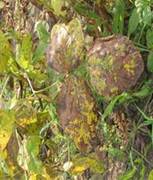
Cultural Control
Mechanical Control
Rust (Phakopsora pachyrhizi)
Symptoms
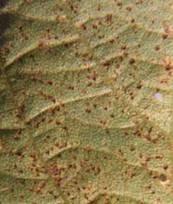
-
The disease begins with small water soaked lesions which gradually increase in size, turning from grey to tan or brown.
-
Tan to dark brown or reddish brown lesions are appear on the underside of leaflets.
-
Lesion may also appear on petioles, pods and stems.
-
In severe case leaf necrosis and complete death of infected areas may result.
Control
-
Deep summer ploughing
-
Do not cultivate soybean in rabi season
-
Use tolerant cultivars like Ankur, JS 80-21, PK 1024, PK 1029.
-
Destroy last crops infected stubble.
Soybean mosaic (Soybean mosaic virus)
Symptoms

-
Infected seeds gets mottled.
-
Diseased plants are usually stunted with
distorted (puckered, crinkled, ruffled, stunted, narrow) leaves.
-
The parts are often stunted or flattened or curved and contain fewer and smaller seed.
-
Infected seeds fail to germinate or they produce diseased seedlings.
Control
-
Deep summer ploughing.
-
Use resistant or tolerant varieties.
-
Use healthy/certified seeds.
-
Keep the field free from weeds.
-
Rogue out infected plants and burn them.
Yellow mosaic (Mung bean yellow mosaic virus)
Symptoms
-
Characteristic symptom is conspicuous systemic bright yellow mottling of leaves.
-
The yellow area are scattered or occur in indefinite bands along the major veins.
-
Rusty necrotic spots appear in the yellow areas as the leaves mature.
Control
-
Grow resistant/tolerant varieties/early maturing varieties.
-
Timely sowing.
-
Maintain weed free fields.
-
Rogue out infected plants and burn them.
Damping Off (Pythium aphanidermatum, pythium debaryanum)
-
Damping off is a serious problem in tobacco nurseries both in heavy clay soils and light sandy soils.
-
It is caused by several soil inhabiting fungi predominant being Pythium aphanidermatum, pythium debaryanum, Phytophthora sp. and some times Rhizoctonia solani are also involved.
-
The disease may appear at any stage of the seedlings but maximum damage is observed 5-6 weeks after sowing.
Symptoms
Disease is noticed in two phases, viz.
- Pre-emergence damping-off
- Post-emergence damping-off
Pre-emergence damping-off
Post-emergence damping-off
-
Post emergence damping- off is the most destructive phase.
-
The tiny two leaved seedlings may disappear due to wet rotting of stems and the seedlings stand diminishes daily.
-
Generally damping-off occurs in patches which spread quickly if unchecked.
-
The older seedlings show shriveling and brown discoloration of the stems near the soils and start rotting under wet soil conditions.
-
The decayed stems collapse and seedlings topple over leaving parchment like brown crest over the soil.
-
The wet rotting and sudden collapse of seedlings starts in circular patches and under wet weather conditions may extend over the whole seedbed causing near total loss.
Control
-
Deep ploughing in summer destroys the fungus
-
Preparation of raised seed beds 15 cm high with channels around to provide drainage
-
Rubbing the seed bed before sowing with slow burn farm waste materials likely paddy husk, tobacco stubbles, waste grass and Palmyrah leaves etc.,
-
Use seed rate 3 Kg/ha only to avoid over crowding of seedlings.
-
Regulate waterings to avoid excessive dampness on bed surface
Schedule of application
-
Application of fungicide should be given one week after completion of germination.
-
Subsequent application, depending upon weather conditions, should be given at 4 days interval if it is bright, sunny and dry, and 2 days when it is cloudy and wet weather. Application should be repeated after every rain.
-
Approximately 40 litres of spray fluid for 40 m2 of seedbeds, applied through a rose-can or 20 litres through knapsack sprayed is required for each application.
Anthracnose (Colletotrichum tabacum)
Symptoms
-
Initially, infection starts on lower leaves as pale-brown circular spots of 0.5 mm diameter with papery depressed centres outlined by slightly raised brown margin.
-
The leaf-spots may remain small with white areas in the centre or coalesce to form large necrotic lesions.
-
Under continuous humid weather, dark brown or black, elongated, sunken necrotic lesion appears on midrib, petiole and stem resulting in petiole and stem rot. Such seedlings do not establish in the field if planted. Primary infection starts from affected bits of aerial parts left in the soil in the previous season.
-
The pathogen is not seed-borne but persists in the soil on dried plant debris.
Control
-
Raised seed beds and rabbing with farm wastes help in reducing the initial infection
-
Removal and destruction of all diseased debris minimises the pathogen in the soil.
-
Discarding the diseased seedlings especially with necrotic lesions on stem will save gap filling in the field.
Black shank (Phytophthora parasitica var. nicotianae)
Symptoms
-
In nursery the affected seedlings show blackening of roots and stem near soil. Under wet weather conditions the conidial infection spreads to leaves, which show water soaked lesions resulting in leaf blight and collapse.
-
The leaf blight phase of the disease, though rare in occurrence spreads very rapidly during cloudy and continuous cyclonic weather resulting in heavy damage.
-
Under such conditions large circular, black or brown water-soaked lesions appear on the basal leaves.
-
In the field blackening starts at the collar region and spreads both downwards and upwards causing rotting and necrosis of the whole stem including basal leaves.
-
First sign of infection seen in the vigorously growing plants is yellowing of leaves, sudden wilting and ultimately death of plants under warm weather.
-
The disease appears in scattered patches in the field.
-
The stems of such plants when split open show brown to black dried pith in disc like plates characteristic of black shank.
Control
-
It can be checked in the nursery by rabbing the seedbeds
-
At the time of transplanting, seedlings with blackened stem should be discarded to prevent spread of disease to field.
-
Grow resistant varieties like 'Beinhart 1000- l' and 'NC 2326' which are moderately resistant can be used. A bidi variety, 'K 20' has good tolerance to black shank under Gujarat conditions.
Powdery Mildew (Erisiphe cichoracearum var nicotiane)
Symptoms
-
Initially greyish white spots (about 0.5-lcm in diameter) appear at the base of the lower leaves of the maturing plant.
-
Under favourable conditions of low temperatures (16° -23° C) and high humidity these white patches spread to upper leaves, enlarge and cover the entire surface of the leaf.
-
Such leaves on curing get scorched and show brown patches rendering them unfit for marketing.
-
Sometimes leaves with incipient infection result in blemished on curing which reduce the commercial value of leaves.
Control
-
Removal of affected basal leaves will help in minimising primary infection and spread of the disease.
-
Early planting to escape cool temperature prevalent at the maturing stage will also reduce the incidence.
-
Use resistant varieties like Swarna or Line 2359 developed at Central Tobacco Research Institute, in disease endemic area.
Frog Eye Leaf Spot (Cercospora nicotianae)
-
Frog-eye leaf spot disease occurs in the seed-beds as well as in main fields. It damages the marketing quality of leaf especially of flue-cured and wrapper tobaccos.
-
The disease is severe on tobacco grown under monsoon conditions.
Symptom
-
Frog eye spots appear mainly on the lower leaves.
-
They are usually circular, brown or tan with dark-brown and pale ashy or white parchment like centre resembling frog's eye at early stages During wet weather they may not be typical as above, as the outline may be angular and the white centre may be absent and they may enlarge from 0.25 cm to 1.5 cm in diameter.
-
During frequent rains large necrotic areas appear which destroy much of the leaf. During hot dry weather, frog eye-spot may be only pinpoint in size.
-
In flue-cured tobacco the same pathogen causing infection at the harvesting time when cured results in innumerable, small, uniform, dark-brown to black spots popularly known as 'Barnspots' which affect the market value of the leaf.
Control
-
The nurseries should be located away from barns and all the diseased debris removed promptly and destroyed.
-
Avoiding excess nitrogen fertilisation and picking over ripened leaves also helps in minimising leaf spotting.
Brown Spot (Alternaria longipes)
Symptoms
-
Initially it appears on lower and older leaves as small brown, circular lesions, which spread, to upper leaves, petioles, stalks and capsules even.
-
In warm weather (30 °C) under high humidity, the leaf spots enlarge, 1-3 cm in diameter, centres are necroses and turn brown with characteristic marking giving target board appearance with a definite outline.
-
In severe infection spots enlarge, coalesce and damage large areas making leaf dark-brown, ragged and worthless.
-
On leaves nearing maturity, leaf spots are surrounded by bright yellow halo, due to production of toxin 'alternin' by the fungus.
-
Extensive toxin production can make the apparently undamaged areas of the leaf cure out dead and black.
Control
Tobacco Mosaic Virus (TMV)
Symptoms
-
Affected plants show leaves with molting or mosaic pattern of light green and dark-green areas.
-
Primary symptoms appear on newly formed young leaves as vein clearing, greenish yellow motling.
-
Infection on young plants results in stunted growth, malformation, distortion and puckering of leaves. Dark-green blisters and some time enations (leafy growth) appear on the dorsal side of the leaf.
-
Immature leaves show varying degree of yellow motling and chlorosis. In severe infection due to a highly virulent strain of TMV, various necrotic dark-brown spots also develop resulting into 'mosaic scorch' or 'mosaic burn' under hot sunny dry spell, damaging large areas of lamina.
-
There are many strains of TMV and symptom expression depends upon the strain and the prevailing environmental factors. Mosaic-affected leaves after curing show green spots which lower the market value of the leaf.
-
The virus is not insect transmitted. The aphid (Myzus persicae) which occurs commonly on the tobacco plant is unable to transmit the virus.
Control
-
Best effective way is to keep the crop mosaic free.
-
Constant vigilance is required right from the seedling stage till harvest involving phytosanitary measures, and nothing can be done once TMV becomes systemic.
-
Infected seedlings should be removed promptly and destroyed.
-
Workers should disinfect their hands with soap and running water before handling seedlings, weeding or doing other cultural operations. Use of tobacco (smoke, snuff, or chewing) should be prohibited strictly while working in seedbeds or field.
-
Weeds (Solanum nigrum) and plant (Brinjal, Tomato, Chillies) susceptible to the virus should be destroyed.
-
In fields showing high incidence of mosaic, rotation for 2 years should be followed.
-
Rouging of the affected plants before first interculturing considerably reduces the spread of the disease.
-
However, in areas where TMV is an over-riding problem, resistant lines developed at CTRI, Rajahmundry, viz. TMVRR-2 and TMVRR-2a, TMVRR-3 can be used to overcome this problem. Spray leaf extracts of Basella alba, Bougainvillea (one litre of extract dissolved in 100-150 litre of water) on 30th, 40th and 50th days after transplanting.
Leaf Curl
Symptoms
-
The most characteristic symptom of tobacco leaf-curl disease is the production of leafy outgrowths known as enations from the veins on the lower surface of the leaves.
-
Combined with this, is a stunting of the whole plant and twisting and curling of the leaves.
-
The manifestation of the disease varies greatly according to environmental conditions and the variety of tobacco concerned.
Control
-
Remove and destroy the diseased tobacco seedlings before and after planting whenever they are seen in the field. Fill the gaps with healthy seedlings if it is not too late.
-
Alternate weed hosts for whitefly should be removed and destroyed.
-
In endemic areas Sesbania sp. may be grown as a barrier crop around tobacco fields.
Tobacco Distorting Virus
Symptoms
-
Affected plants show highly stunted growth, abnormal suckering and the leaf tips are modified into rat-tails.
-
The leaves show typical mosaic mottling, puckering, distortion and suppression of lamina into various shapes leaving only long midrib in extreme cases.
Control
-
Screening the germ plasm for Tobacco distorting virus indicated that besides TMV resistant line TMVRR-l, developed at CTRI, Rajahmundry, there are 23 genetic types (15 exotic and indigenous air-cured types) found resistant to TDV.
-
Growing D.G. 3 (Desi Guntur) is an improved Natu tobacco variety which is resistant to TDV virus
Orobanche
-
Orobanche is popularly known as broomrape in English speaking countries, 'Tokra' in north India, 'vakumba' in Gujarat, 'bambaku' in Maharashtra, 'pokayilaikalan' in Tamil Nadu, 'bodu' or 'malle' in Andhra Pradesh.
-
It is a flowering parasite on tobacco roots and occurs in all the tobacco tracts in India. It is a holoparasite and draws its nourishment from tobacco by means of haustoria attached to the roots of tobacco.
-
The loss in the yield and quality of leaf is very much variable from 30-70% in Tamil Nadu and 10-50% in other states.
-
Experiments conducted at CTRI, Rajahmundry, indicated that loss in yield varied from 20-50% depending on the time of infection and availability of soil moisture.
-
Symptoms In the early stages of infection, symptoms of wilting, drooping and ribbing of leaves are observed in the early hours.
-
These symptoms are the first indication of underground infection of tobacco roots by the parasite.
-
Five to six weeks after planting, young orobanche sprouts emerge from the soil at the base of tobacco plants. Presence of numerous orobanche shoots around the plants in field is the most important visible symptom.
-
Plants attacked early in the season are generally stunted showing typical wilting of leaves. Plants attacked late in the season do not show visible symptoms of infection but the yield and quality of leaves are reduced.
-
Orobanche emerge in clusters, they are 15-45 cm tall, pale brown or purple in colour. Often 10-15 shoots are found attached to the roots of a single host plant.
-
Of the two species reported in india, viz. Orobanche cernua and O.indica, the former is more a serious parasite on tobacco and it is restricted to solanaceous plants.
-
Some more hosts in other families, e.g. Cannabinaceae, Compositae, Euphorbiaccae and Tiliaceae. Further he noticed that Capsicum annuum (chillies) and Tridax procumbens stimulated germination of orobanche seed without getting parasitised.
-
The seed is reported to be viable for 2 years though and remained dormant in the soil for at least 13 years.
Control
-
Prevention of formation of the inoculum potential form the basis of orobanche control. Regular weekly hand pulling of tender orobanche shoots before they set seed, has reduced the original stand by 85% after 2 years and by 96% after 4 years.
-
Periodical hand pulling carried out meticulously by every grower in a large block for at least 4 years will give adequate control of this menace.
-
Incidence of orobanche was much reduced in tobacco following jowar or gingelly in kharif but chillies though reported to be a trap crop failed to give the same effect that Sinapisalba as a spring gap crop preceding tobacco considerably reduced orobanche emergence.
-
Working on the effect of dates of planting on the incidence of orobanche, that late planting reduced the incidence of orobanche but the crop growth is also affected mainly due to soil moisture stress.
|


























